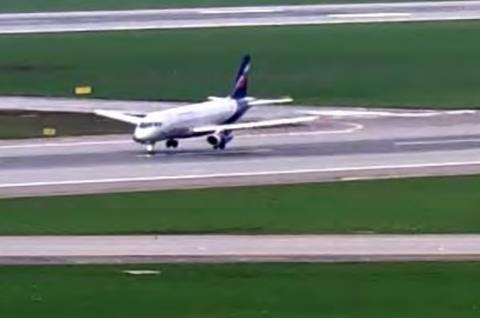Russian authorities have sentenced the captain of an Aeroflot Sukhoi Superjet 100 to six years in an open penitentiary over the fatal landing accident at Moscow Sheremetyevo four years ago.
The aircraft departed Moscow for Murmansk on 5 May 2019, and had just been cleared to climb to 11,000ft when it suffered a lightning strike, prompting the crew’s decision to return to the airport.
But it landed hard, causing structural damage to its fuel tanks. Leaking fuel ignited and the twinjet slid to a halt, its aft fuselage consumed by fire.
Although an evacuation was initiated, 41 of the 78 occupants, including a crew member, did not survive.
Russia’s federal Investigative Committee disclosed in October 2019 that the captain, Denis Evdokimov, had been charged with violations of procedures, leading to the fatalities and the aircraft’s destruction.
The Investigative Committee says a court has found Evdokimov guilty of the charges.
Flight and forensic data gathered during the inquiry made restoration of the circumstances possible, it states.
“Investigators and specialists studied the flight-recorder data of the crashed aircraft, according to which the aircraft adequately responded to the pilot’s control actions,” it points out.
“This information refutes the defendant’s version of a possible aircraft malfunction.”

Air traffic control and Sheremetyevo’s rescue services were unable to prevent the accident, the Investigative Committee adds.
The court sentenced Evdokimov to a six-year term in the penitentiary. It has also issued a fine of Rb2.5 million ($28,400) and imposed a ban on holding the position of pilot for three years.
Russia’s air accident investigation agency, the Interstate Aviation Committee, has yet to publish the final report into the event. The inquiry has been held up by the pandemic, which restricted personnel movements, as well as difficulties in obtaining certain system data.
Investigators have completed a draft report and, in May, stated that it would be submitted to authorised representatives for comment.
But their previous preliminary analysis found the aircraft was hit by lighting 6min into the flight. The autopilot disengaged and the aircraft reverted to direct flight-control law.
Its crew decided to return to Sheremetyevo, with the captain operating the jet manually, but initially had difficulty establishing radio contact with air traffic control.
Flight-data recorder analysis showed the captain’s control inputs were abrupt and heavy-handed, and the initial attempt to line up with the runway was abandoned.
When the aircraft was cleared for a second approach to runway 24L, the crew continued the descent – despite a windshear alarm – but as the jet neared touchdown, its pitch fluctuated with the captain’s strong inputs on the sidestick.
The aircraft landed hard in a flat attitude, with all three landing-gear assemblies contacting the runway almost simultaneously. There was no automatic spoiler deployment, as the jet was operating in direct law, and the crew did not extend them manually.
After the heavy touchdown the aircraft bounced. The captain attempted to engage reverse-thrust, which had no effect because the jet was no longer on the ground.
Manual input pitched the aircraft downwards, and it contacted the runway nose-gear first. This impact was harder than the previous one, and the jet bounced a second time. The crew then pushed the thrust levers forward, possibly for a go-around attempt, but this failed owing to the prior activation of reverse-thrust.
As a result, the aircraft descended to the runway, landing hard again and causing substantial structural damage including the fracture of the fuel tanks.

























